An ultra-rich and ultra-bored lady in a fallout shelter, the feminist version of a mythological Phoenician princess, future inhabitants of a detention camp for immigrant teleporters but also avatars, cosplayers and idealised lives on Instagram… An exhibition at Osservatorio Prada in Milan explores real stories behind made-up identities.
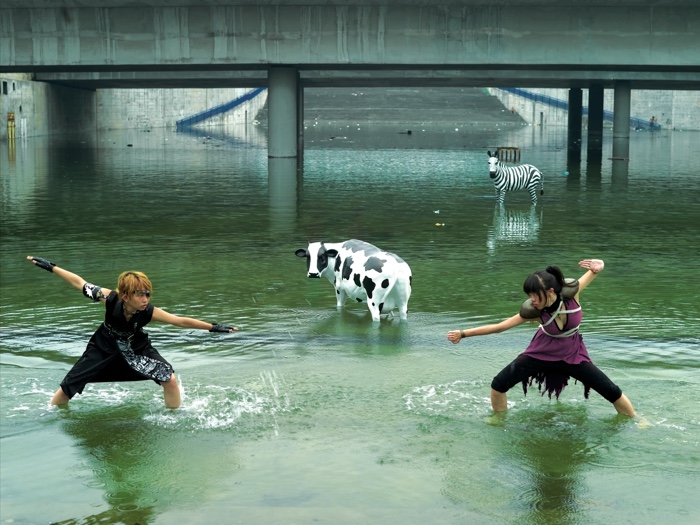
Cao Fei, Cosplayers, 2004
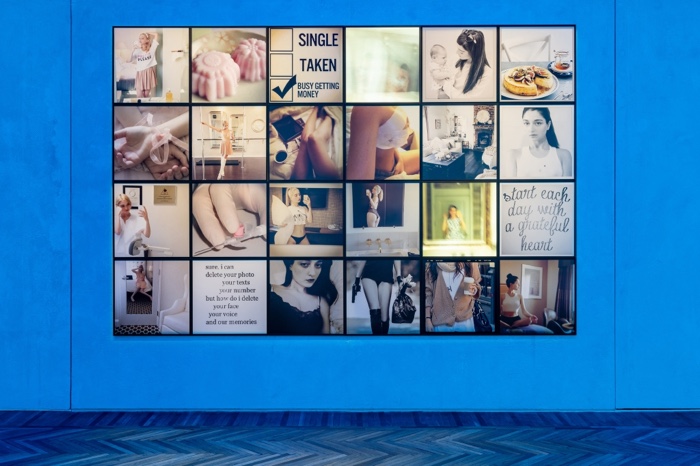
Amalia Ulman, Excellences and Perfections–New Installation, 2015-2022. Exhibition view of “Role play” Osservatorio Fondazione Prada, Milano. Photo: Delfino Sisto Legnani @delfinosl Courtesy: Fondazione Prada
Role Play shows how artists juggle gender tropes, racial clichés, personal experiences and social aspirations to forge unique or multiple alter-egos that scrutinise, reinvent or interrogate the concept of individuality.
As underlined by curator Melissa Harris, “Since the early twentieth century, projects engaging role-play have further contemplated identity, liberating artists to gender-bend and time-travel and envision their selves in myriad ways, in turn reflecting on their very is-ness—even when that is in flux. An alter ego, persona or avatar may be aspirational; it may relate to one’s personal and cultural history and sense of otherness; it may be a form of activism, or a means of maneuvering through entrenched, even polarized positions, toward empathy: putting oneself in another’s shoes.”
I liked how the show managed to give a more militant edge to a theme that has been explored over and over again. Role Play shows how alternative identities can bring out unpleasant truths and even capsise conventional representations of gender, ethnicity and class
The exhibition, both thoughtful and entertaining, is set inside a vast light installation project conceived by the creative agency Random Studio. The blue and eerie atmosphere evokes virtuality but also reminds us that, from childhood games to theatre, identity-shifting has always been part of the human experience.
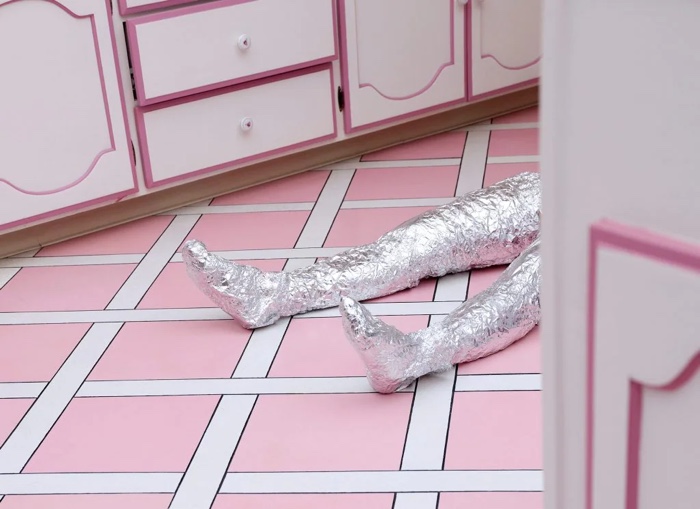
Juno Calypso, Die Now Pay Later, 2018. From the series What To Do With A Million Years
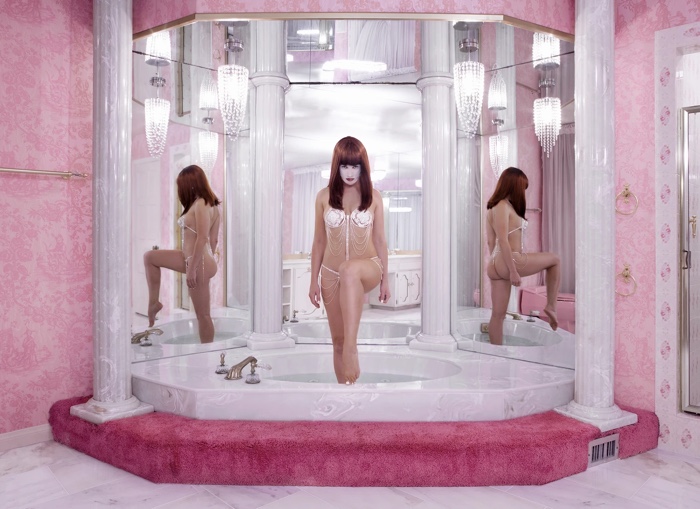
Juno Calypso, A Clone of Your Own, 2017. From the series What To Do With A Million Years
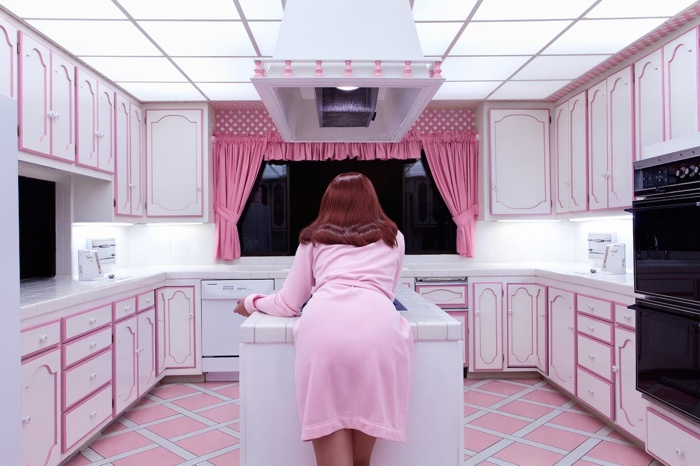
Juno Calypso, Subterranean Kitchen, 2019. From the series What To Do With A Million Years
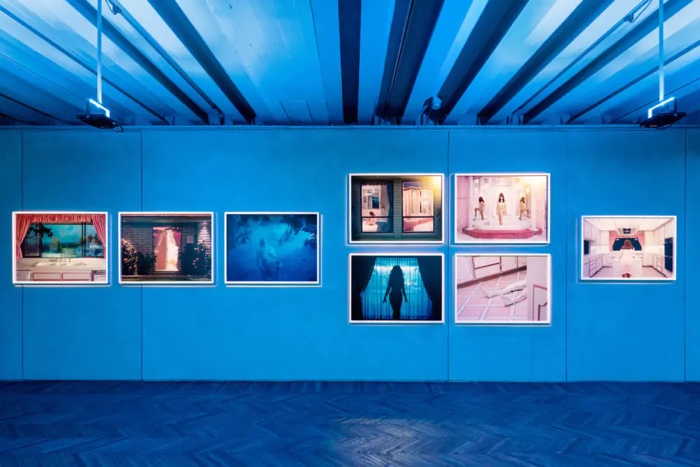
Juno Calypso. Exhibition view of “Role play” Osservatorio Fondazione Prada, Milano. Photo: Delfino Sisto Legnani @delfinosl Courtesy: Fondazione Prada
Juno Calypso‘s scenes seem to take place in the kind of fake architecture that the movie industry designs to provoke unease and eeriness. Except that the house of the series What To Do With A Million Year is real. It was built as a nuclear shelter during the Cold War era by a businessman who made a fortune selling beauty products. His plan was to live there with his wife Mary while the world outside was exploding and melting.
Buried underneath an ordinary two storey house on a residential street, the giant bunker comes with 1970s style pink interiors, chandeliers, a dance floor and a swimming pool. There is even an artificial garden with fake trees, fake lawn, painted backdrop scenes and lights that can switch from dawn to daylight to dusk.
The house is now inhabited and owned by a mystery society with an interest in cryonics and the prospect of immortality.
Juno Calypso managed to get access to the house. She spent almost three weeks, immersing herself in the atmosphere of this time capsule. The self-portraits she staged in the different rooms try and imagine “what the wife would be doing in this immaculate house, free from the dangers of the world upstairs but also cut off and isolated from it.”
What makes this series so disturbing is the way the photos, shot inside a nuclear bunker currently owned by people who believe in immortality, evoke death far more than they suggest life.
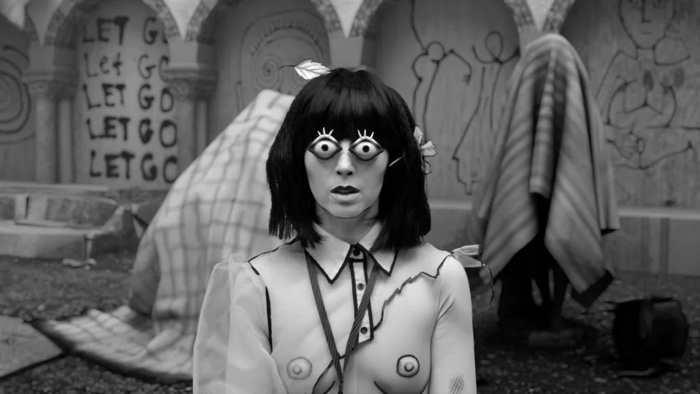
Mary Reid Kelley and Patrick Kelley, The Rape of Europa (video still), 2021
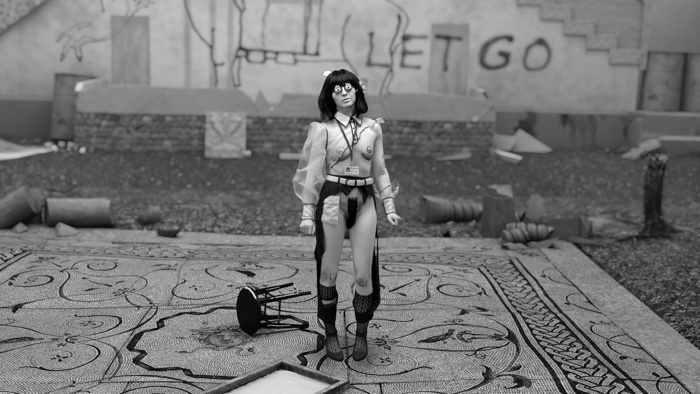
Mary Reid Kelley and Patrick Kelley, The Rape of Europa (video still), 2021
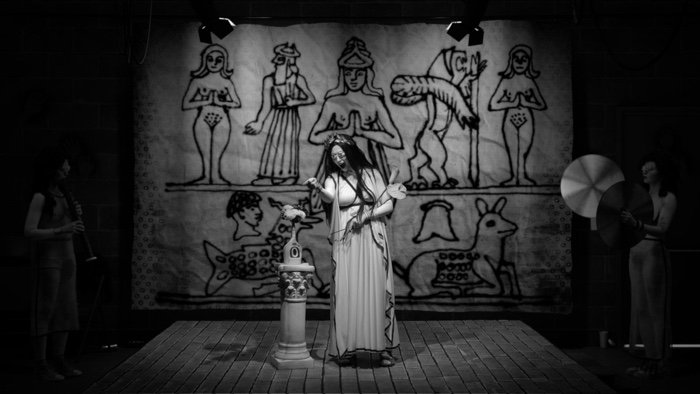
Mary Reid Kelley and Patrick Kelley, The Rape of Europa (video still), 2021
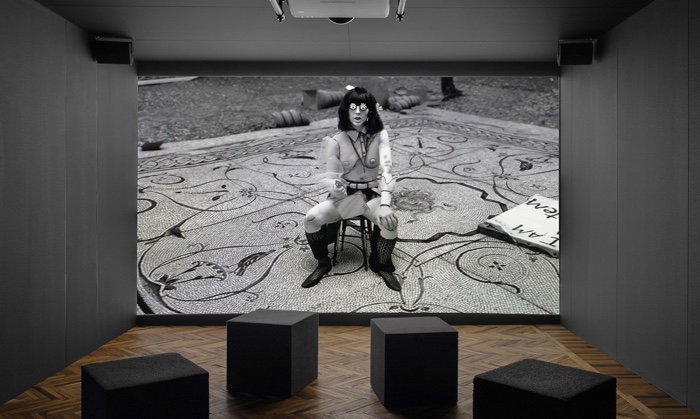
Exhibition view of “Role play” Osservatorio Fondazione Prada, Milano. Photo: Delfino Sisto Legnani @delfinosl Courtesy: Fondazione Prada
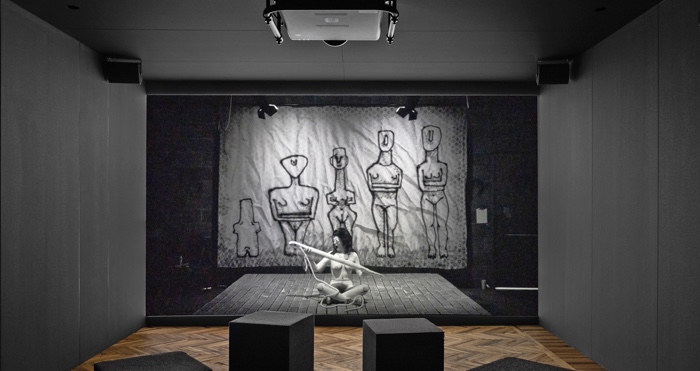
Exhibition view of “Role play” Osservatorio Fondazione Prada, Milano. Photo: Delfino Sisto Legnani @delfinosl Courtesy: Fondazione Prada
In Greek mythology, Zeus decided to seduce or rape (the two being near-equivalent in Greek myth) Europa. He transformed himself into a white bull and fled with her on his back to the island of Crete.
Titian’s famous 1562 painting The Rape of Europa paints the moment Europa was kidnapped. She appears as a defenseless and sensual woman, a typical depiction of women in Western art at a time when they lacked any political agency.
Mary Reid Kelley and Patrick Kelley‘s short film, commissioned to respond to the Venetian artist’s painting, gives Europa guts and dignity.
The film features Mary Reid Kelley playing a range of characters trapped between comic and tragic scenarios. Her humour, energy, bold language and outfit liberate women like Europa from the subservient role they have long been reduced to.
The characters she plays use rhymes and puns to articulate feminine and feminist issues that interconnect mythology, the #MeToo movement and contemporary life in the West: misogyny, abuses, carb-free and lactose-free diet, the fear of being pregnant but also the accomplishments of women in early history.
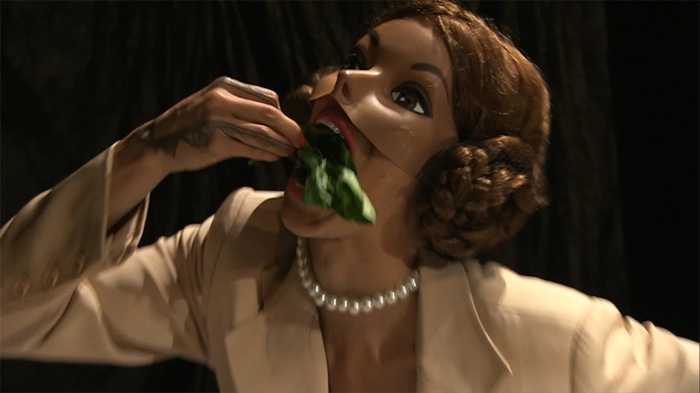
Narcissister, Narcissister Organ Player, 2018
Narcissister, Narcissister Organ Player (trailer), 2018
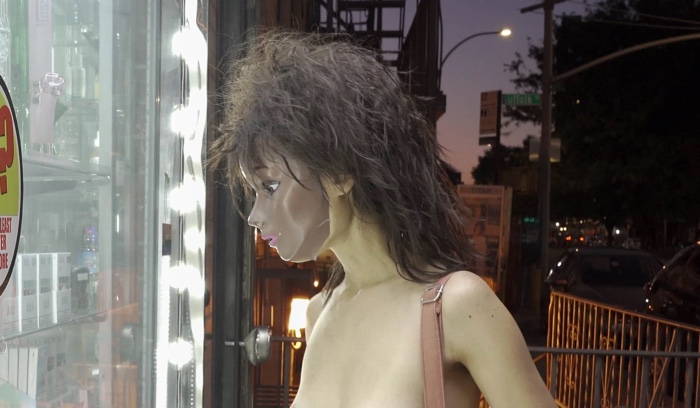
Narcissister, Breast Work, 2019
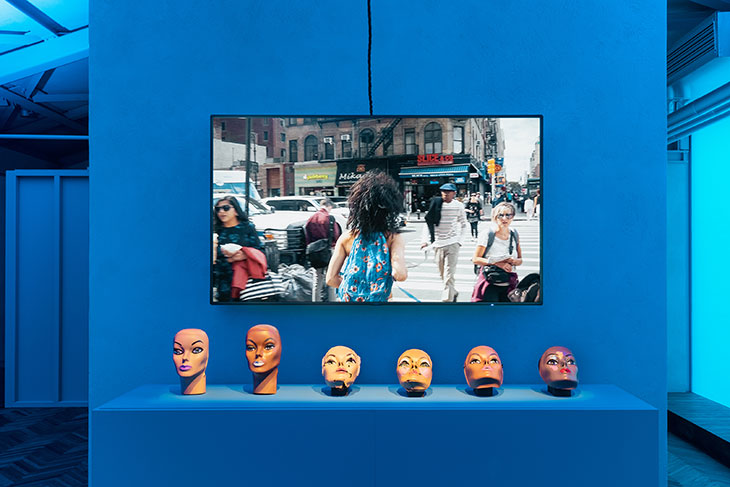
Narcissister, Narcissister Masks, 2007–21. Exhibition view of “Role play” Osservatorio Fondazione Prada, Milano. Photo: Delfino Sisto Legnani Courtesy: Fondazione Prada
Narcissister’s true identity is unknown to the public. The artist and activist always wears a mask in her works as a way to communicate ideas of what it means to be a woman and a person of color, putting aside her own individual experience.
Breast Work focuses on the right to go bare one’s breasts in public. By showing women walking topless in the streets of New York, Narcissister explore how this simple act can make a woman feel both powerful and vulnerable. Removing your top is seen as both erotic and immoral. Even breastfeeding women face judgments and criticisms.
The film looks at how the imbalances built into everyday gender experience are grounded in the fear of and the desire to control the female body.
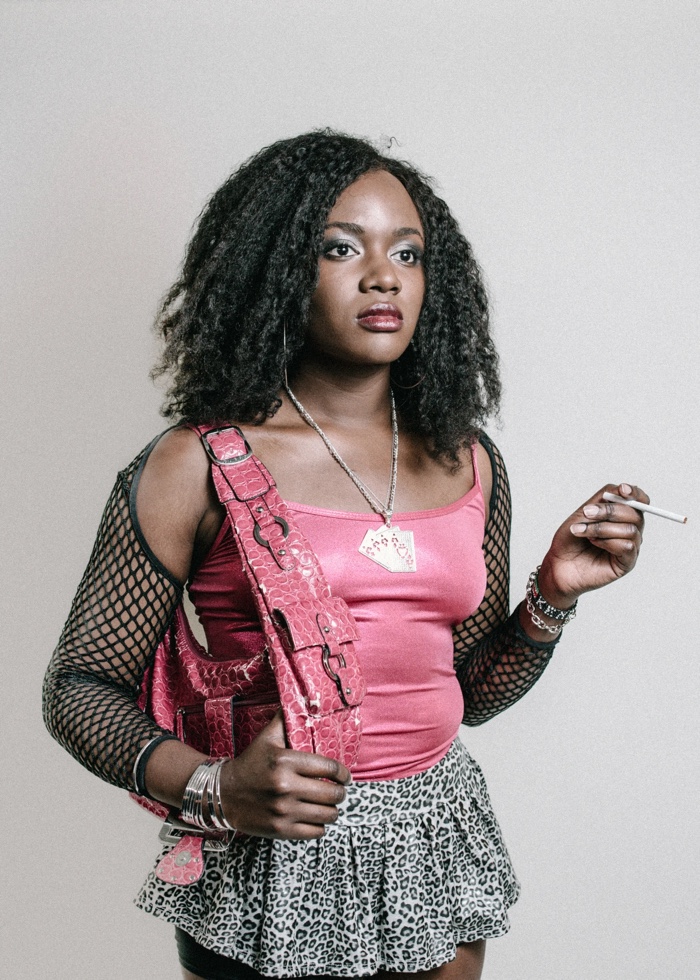
Haruka Sakaguchi and Griselda San Martin, Typecast Project, 2019
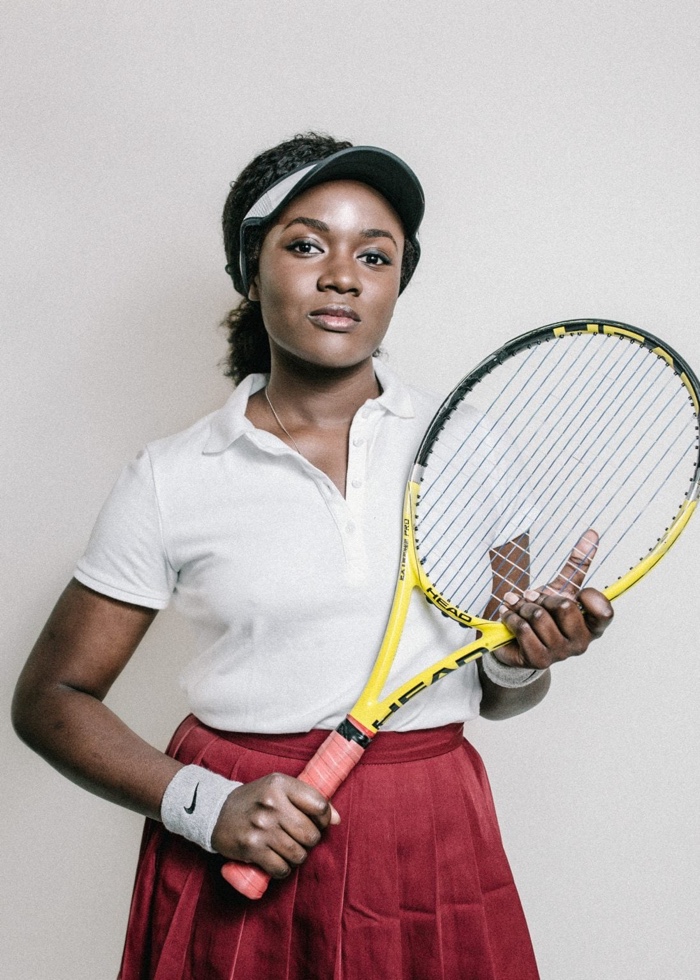
Haruka Sakaguchi and Griselda San Martin, Typecast Project, 2019
Lack of diversity is one of the most deep-rooted problems in the film industry. When Haruka Sakaguchi and Griselda San Martin started working on this project, ethnic minorities constituted nearly half of the US population but only 13.9% of leading roles were being played by POC actors. Even thought the situation has slightly improved over the past 2 years, racial inequities and stereotypes persist in the entertainment industry.
The Typecast Project photo series aims to challenge negative stereotypes of ethnic minorities and present POC actors in nuanced protagonist roles. Sakaguchi and San Martin made 2 portraits of POC actors. In the first one, the actor embodies the kind of cliché roles they are offered. The second portrait shows them in their ideal roles.
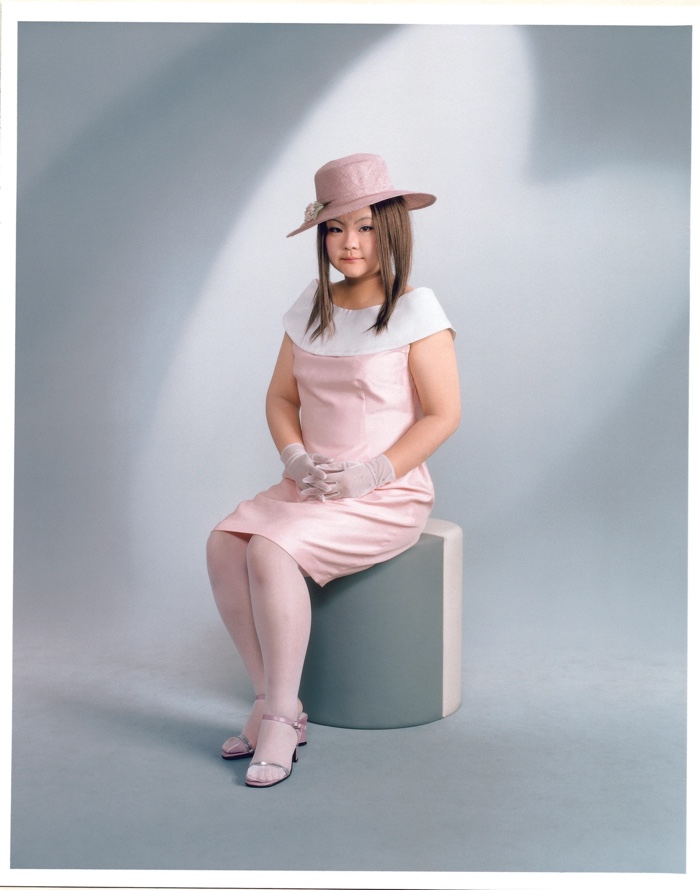
Tomoko Sawada, OMIAI♡, 2001
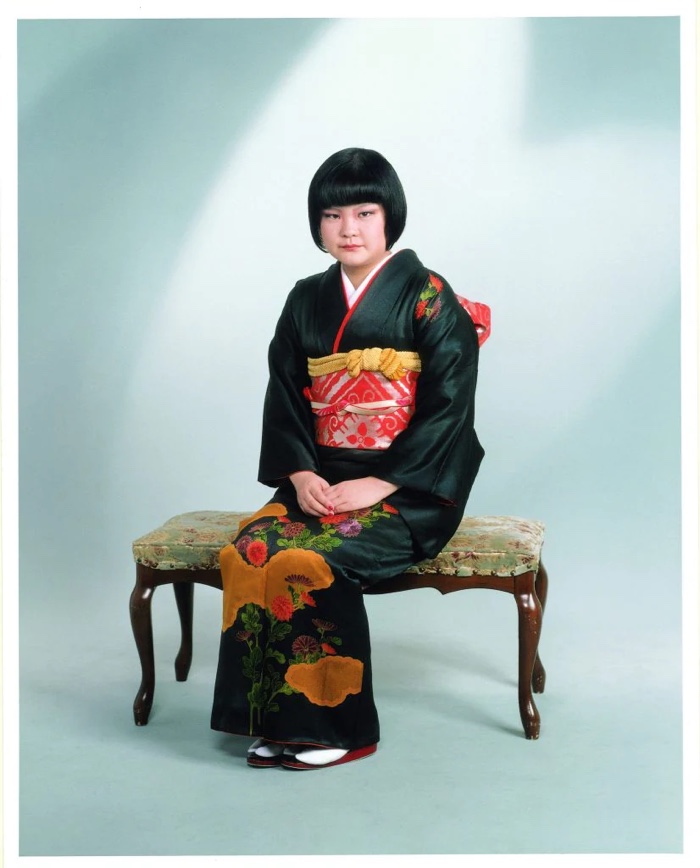
Tomoko Sawada, OMIAI♡, 2001
Tomoko Sawada transformed herself into thirty different potential wives for potential husbands. The portraits imitate the photographs provided in the Japanese tradition of omiai. When arranged marriages are being prospected, the parents of potential spouses exchange photographs of their children that offer a flattering and reassuring appearance.
Sawada describes herself as a photographer who does not shoot: her portraits were taken by a studio specializing in pre-wedding photos. The identity she projects in each portrait is always different. Yet, she is the same person.
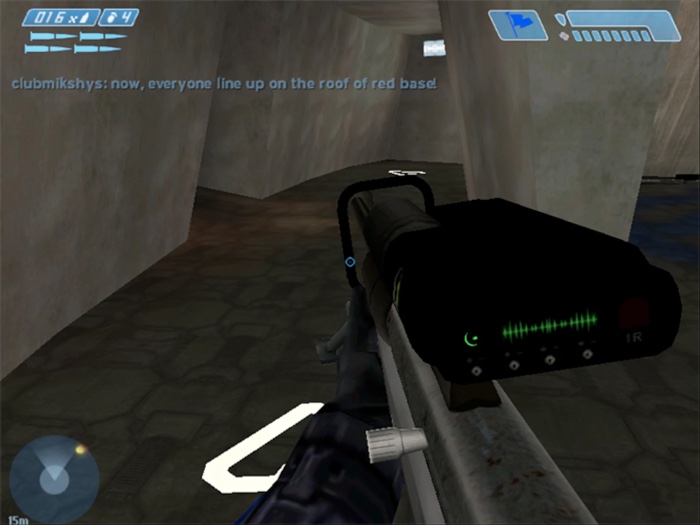
Darius Mikšys, A Piece for A Peace, 2006
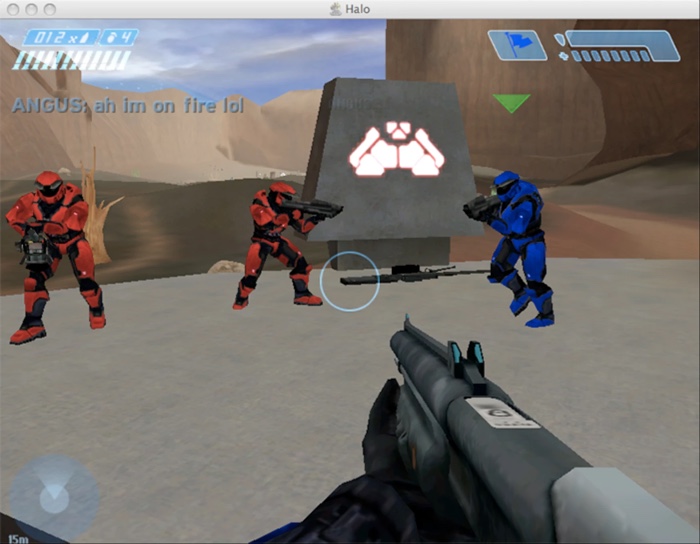
Darius Mikšys, A Piece for A Peace, 2006
A Piece for A Peace is a series of screenshots documenting Darius Mikšys’ attempts to interrupt an online multiplayer shooter game. The artist would choose particularly heated moments in the game to ask other players (whom he did not know) to temporarily put aside their action-packed mission and participate in a group photo session. By doing this, Mikšys abandons his identity as an aggressive warrior and invites other players to do the same, further blurring the borders between real and fictional identity.
More works and installation shots from the exhibition:
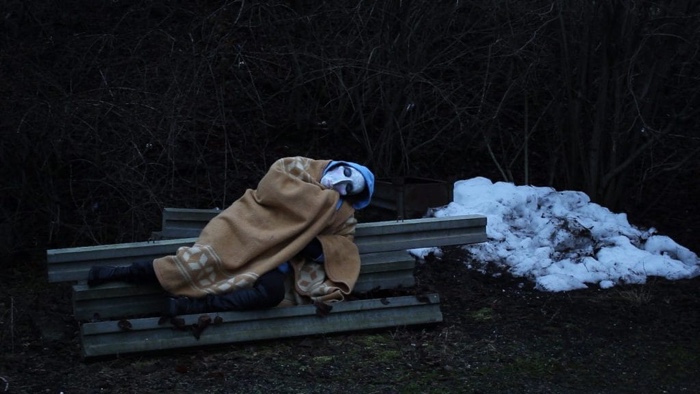
Beatrice Marchi, When Katie Fox Met the Evil Turtle (video still, 2021-22
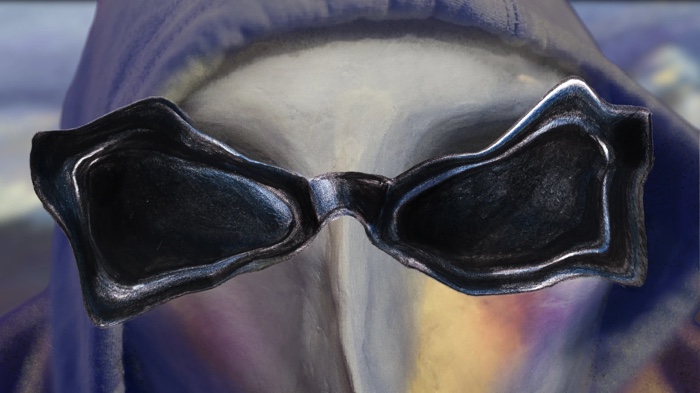
Beatrice Marchi, When Katie Fox Met the Evil Turtle (video still, 2021-22
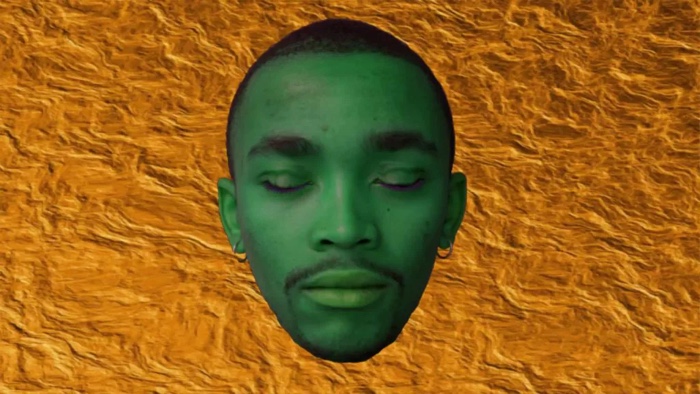
Bogosi Sekhukhuni, Consciousness Engine 2: absentblackfatherbot, 2013
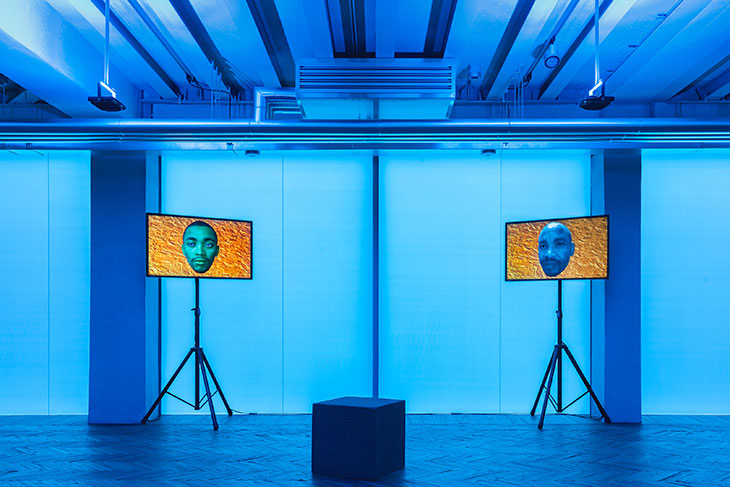
Bogosi Sekhukhuni, Consciousness Engine 2: absentblackfatherbot, 2013. Exhibition view of “Role play” Osservatorio Fondazione Prada, Milano. Photo: Delfino Sisto Legnani @delfinosl Courtesy: Fondazione Prada
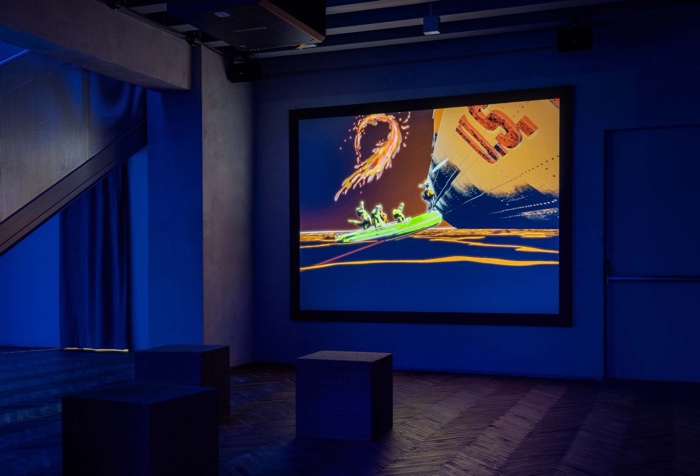
Meriem Bennani, Guided Tour of a Spill (CAPS Interlude), 2021. Exhibition view of “Role play” Osservatorio Fondazione Prada, Milano. Photo: Delfino Sisto Legnani @delfinosl
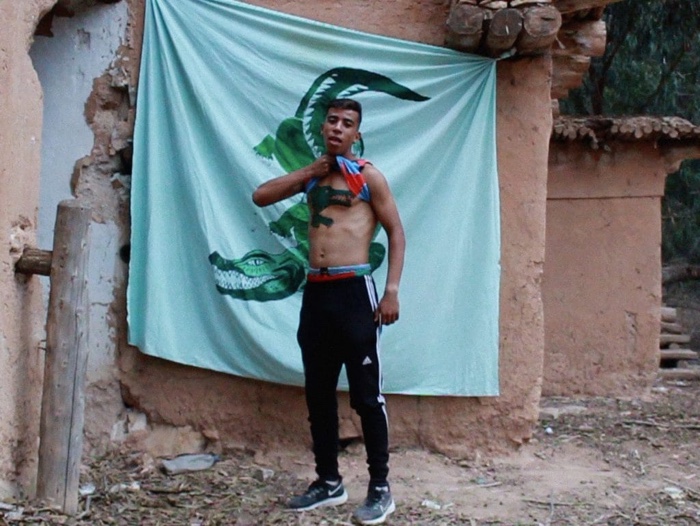
Meriem Bennani, Guided Tour of a Spill (CAPS Interlude), 2021
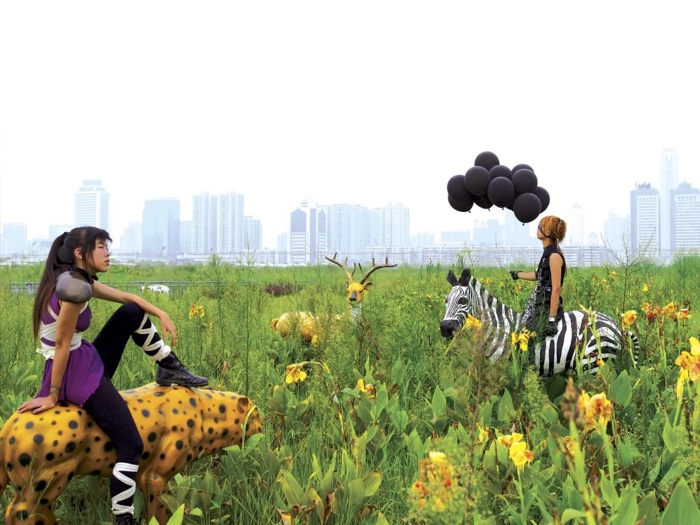
Cao Fei, Cosplayers, 2004
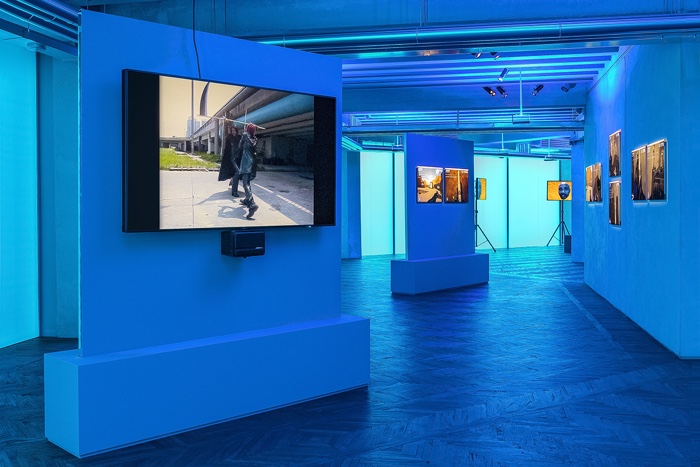
Cao Fei, Cosplayers, 2004. Exhibition view of “Role play” Osservatorio Fondazione Prada, Milano. Photo: Delfino Sisto Legnani @delfinosl Courtesy: Fondazione Prada
Role Play, curated by Melissa Harris, is at the Osservatorio Prada in Milan until 27 June 2022.
Previously at Osservatorio Prada: Training Humans. How machines see and judge us.
